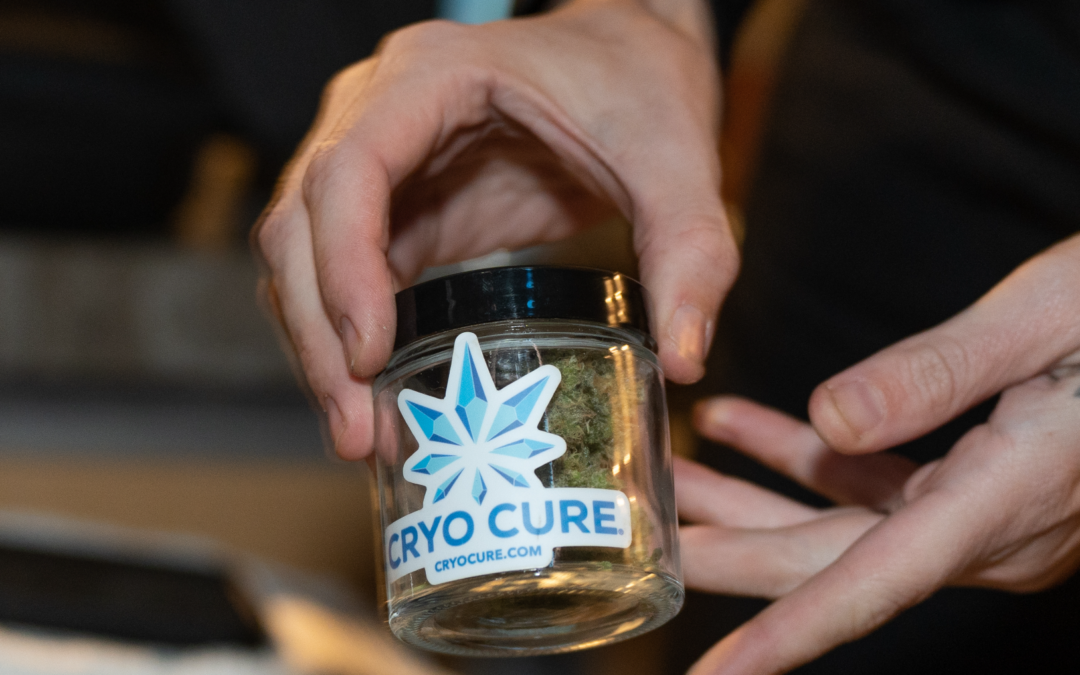Cultivating top shelf cannabis flower takes time, patience, and resources, but the reward in the end is a premium cannabis flower that speaks for itself. Of course, there are a lot of factors that contribute to the overall quality of cannabis flower; virtually everything a plant experiences throughout its life can influence the final product. To cultivate truly top shelf flower, the process requires attention to detail and reliance on the latest best practices and techniques the cannabis industry has to offer.
What is top shelf cannabis?
Top shelf cannabis is flower that’s often above and beyond what’s typically sold in a dispensary. This could be judged on the size of the bud, levels of THC and other cannabinoids, terpene levels, and other factors.
Everything from bag appeal to nose and flavor to the consumption experience will be demonstrably exceptional, even to the most experienced consumers. Truly premium cannabis can be identified by its appearance, aroma, consistency, and experience, all of which belies the effort a cultivator puts into growing such high quality buds.
What goes into producing top shelf cannabis?
The best cultivators maintain tightly controlled environments so their plants experience the ideal growing conditions throughout their entire life cycle and post-harvest. Here’s an overview of some of the key aspects that go into producing top shelf cannabis.
Genetics
Everything starts with genetics. Genetics affect everything about your plant, including potency, flavor, appearance, yield, overall health and durability, and the consumption experience.
To grow top shelf flower, you need top shelf genetics, so sourcing your seeds from reliable breeders who focus on quality is always key. Whatever cultivar you plan to grow, be sure the parents of your seeds were strong, healthy flowers chosen by the breeder specifically for their exceptional traits.
Sourcing top shelf genetics requires establishing a relationship and partnership with breeders you can trust. For any cultivator interested in consistently producing the very best flower, networking with breeders and understanding how they develop their seeds is a crucial step.
Grow medium
Once you’ve acquired your seeds and confirmed the quality of the genetics, it’s time to select a grow medium. Each cultivator has their own preferences when it comes to growing medium. Some work with a soil mix, others prefer soilless mediums like coco coir, and some rely on hydroponics. There’s no right or wrong medium, necessarily, but there are some key considerations that apply no matter what medium you select.
- pH levels: Cannabis plants require a slightly acidic grow medium in order to take up nutrients. If pH falls outside the optimal range, it doesn’t matter how many nutrients are available, the plant will not be able to make use of them. Exactly how acidic the medium should be depends on which you’ve chosen. Soil mixes should range between 6 and just below 7. For coco coir or hydroponic grows, aim slightly more acidic in the 5.5 to 6.5 range. Some fluctuation of pH in these ranges is desirable, as it will ensure the full range of nutrients are taken up by the plant during its life cycle.
- Nutrients: Cannabis plants need a range of nutrients to grow to their fullest potential. These include three key micronutrients: nitrogen, which promotes leaf and stem growth in both the vegetative and flowering stage; phosphorus, which encourages the growth of big, healthy buds in the flowering stage; and potassium, which encourages strong plants that won’t wilt. In addition, cannabis plants can benefit from macronutrients like boron, cobalt, copper, iron, manganese, silicon, and zinc.
- Microbes: For soil grows, certain bacteria and fungi are beneficial for cannabis plants, creating a symbiotic relationship in the grow medium that makes nutrients more bioavailable to the plant. This is important to optimize growth and bloom. Some beneficial microbes include endomycorrhizal fungi, ectomycorrhizal fungi, microorganisms that serve to decompose minerals so nutrients can be better absorbed by the root system. These microorganisms can also serve to ward off pests and diseases that can harm cannabis plants.
Cultivation environment
Finally, the environmental conditions in the grow room are critically important to growing top shelf cannabis. Even if you start with the best genetics and your grow medium and nutrients are precisely optimized, environmental conditions still need to be ideal in order to produce top shelf flower. Some of the most important factors in a grow room environment include:
- Temperature and Humidity: The ideal temperature and relative humidity for cannabis plants changes throughout its life cycle, like most conditions that influence its growth. During the vegetative stage, when a plant is producing most of its leaves and experiencing stem and node growth, temperature should range between 70℉ and 78℉, while humidity should remain between 45% and 55%. During flowering, both temperature and humidity should drop a bit to simulate the end of the growing season, signaling to the plant it is time to put all its energy into growing big, resinous buds that can be fertilized before winter so it can drop its seeds and make way for the next generation. During flowering, temperature should range from 68℉ to 75℉, while humidity should range from 35% to 45%.
- Light: Cannabis plants not only need the right brightness of light for the appropriate amount of hours each day, they also need the right spectrum of light. In the vegetative stage, cannabis plants require a minimum of 13 hours of light each day, though many cultivators opt for as many as 18 hours of light. During the flowering stage, plants need up to 12 hours of light per day. Additionally, the ideal light spectrum for cannabis plants in their vegetative stage is blue light at a wavelength between 400 and 500 nm, while during flowering they do best with red light between 620 and 740 nm.
- Stress: Some stress is good for cannabis plants, but too much will overwhelm them. Think of it like working out: lifting weights is good to a point, but overtraining will result in injury. In nature, cannabis plants deal with strong winds and animals passing by, so simulating this with techniques like low stress training, supercropping, and topping can be helpful to encourage strong growth. Just be careful not to over-stress your plants.
Drying and curing
The way in which cannabis is dried and cured after harvest is critical not only to its quality but also to its shelf life. Drying and curing cannabis is intended to reduce moisture content to optimal levels to prevent contamination by mold and mildew, as well as improving how it smokes and preserving the maximum amount of cannabinoids and terpenes.
Traditionally, mature cannabis plants are chopped down and hung from a string or wire in a drying room. The conditions in the drying room are important; temperature should range from 60℉ to 70℉ and humidity should range from 45% to 55%. Ideally, the drying room should be kept dark as well, because light can cause cannabinoid and terpene degradation. Finally, airflow is needed to ensure the buds are evenly dried. Most cultivators will use cold air flowing from the ceiling to the floor.
Once the drying process is complete, the dried flower must be cured to equalize the moisture content throughout all the buds. To do so, the dried flower is placed in an airtight container, such as plastic bags. During this process, the remaining moisture in the larger buds will be absorbed by the smaller ones, resulting in a balance.
This process can take weeks in total to get the flower to an ideal place, where its moisture content ranges from 8% to 12% and water activity is no more than 0.6 aW, the ideal conditions to preserve flower for the long haul and reduce the risk of contamination.
Drawbacks of conventional drying and curing
While taking great care to ensure conditions in the drying room are ideal, conventional approaches to drying and curing leave a lot to be desired. Unfortunately, even the most meticulous cultivators will inevitably see a degradation of their flower’s quality during this process, which takes weeks to complete.
Cannabinoid and terpene degradation
During that time, even favorable environmental conditions will cause the degradation of cannabinoids and terpenes. These compounds naturally degrade over time when exposed to oxygen, light, heat, and humidity. And while cultivators can control these conditions in their dry room, degradation is natural and will inevitably occur over the weeks it takes to dry and cure the flower.
Dulled and shrunken buds
Additionally, as the flower is dried and cured, the buds tend to shrink. As moisture is evaporated from the buds to preserve them, the fluffy, bountiful appearance diminishes and some of the vibrant colors that can be viewed at harvest fade. This results in reduced bag appeal, which can directly impact sales.
What about freeze drying?
To try and get around these drawbacks, some cultivators have tried freeze dryers for the drying and curing process. And while freeze dryers indeed significantly reduce the time the process takes, freeze dryers aren’t specifically built for cannabis and cause additional problems that ruin the integrity of the flower.
Zapping the moisture out of freshly harvested buds leaves them too dry. While the purpose of drying and curing is to reduce moisture content, it is important that roughly 6% to 12% moisture content remains for the flower to retain its freshness. Overly dry flower not only produces a harsh smoke but will also lose all its terpenes, eviscerating its aroma and flavor.
Additionally, the trichomes of freeze dried flower will be extremely brittle and liable to break off, reducing the potency of the bud. In other words, freeze drying top shelf flower with equipment not made specifically for cannabis is a sure way to diminish quality.
While top shelf flower remains high quality after the conventional drying and curing process, it’s not the very best it can be. Luckily, there’s a better way to preserve top shelf flower at its very best and help cultivators realize a return on their investment much more quickly.
Beyond top shelf: Producing Live Cured Flower with Cryo Cure
Cryo Cure’s globally-patented method of drying and curing cannabis flower not only expedites the process to as short as 11 to 14 hours, it also ensures that cannabinoids and terpenes are preserved at their freshly harvested levels and that moisture content remains in that ideal 6% to 12% range. There’s no shrinkage or dulling of the buds, cannabinoid and terpene content remains at its maximum, and your top shelf flower remains just that — top shelf.
That’s why we call freshly harvested flower dried and cured using Cryo Cured “Live Cured Flower.” It’s as close as you can get to cannabis flower on a live plant, only in a smokable form that provides a smooth, flavorful experience. The consistency of the bud speaks for itself, as well; there’s no need for a grinder with Live Cured Flower, which easily breaks apart in your hand thanks to its ideal moisture content.
Take top shelf to the next level with Live Cured Flower
When you’ve put all your time, energy, and care into growing top shelf flower, make sure it stays that way when it reaches your customers. From bag appeal to aroma and flavor, potency to consumption experience, Cryo Cure ensures the quality of your top shelf flower shines through even after the long trip to market.



